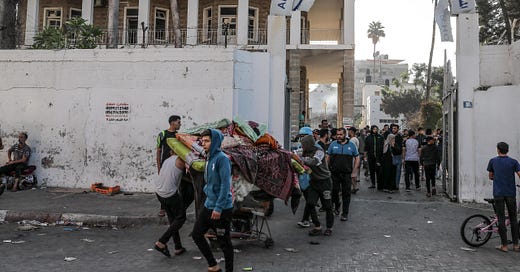Rush to Judgment and Bias on Gaza Hospital Story
The facts emerged gradually, but many journalists and activists seemed eager to shift to a blame-Israel narrative.

TUESDAY’S EXPLOSION at Al Ahli Arab Hospital in Gaza City, which killed a still-undetermined number of people and injured many more, was a horrific tragedy for those who sought refuge at the hospital building from a war raging around them. In the ensuing rush to report and comment on the deadly incident, many journalists, activists, and politicians shamefully ran with an insta-narrative blaming Israel for the attack, and often persisted in this narrative even as it looked more and more discredited. This fiasco reflects the complicated nature of fog-of-war reporting in the age of social media and rapid reactions—and it raises uncomfortable questions about journalistic ethics, bias, and political integrity.
The blast at the hospital happened around 7 p.m. local time, or 12 p.m. EST. Tweets reporting carnage caused by Israel quickly began to appear. Just after 2 p.m. EST, Rep. Rashida Tlaib (D-Mich.), a Palestinian-American, reposted one such report with her own comment1:
Leading media organizations amplified the claim. The original New York Times headline read, “Israeli Strike Kills Hundreds at Gaza Hospital, Palestinians Say.” The second version was, “At Least 500 Dead in Strike on Gaza Hospital, Palestinians Say,” with a subhead that reported the Israelis’ counterclaim of a misfired Palestinian rocket. The next version changed “Strike on” to “Blast at.” And the final version currently on the site: “Hundreds die in an explosion at a Gaza hospital, Palestinian officials say, setting off exchanges of blame.”
After many hours of back-and-forth claims, analysis of grainy videos by instant experts on rocket science, and viral amplification for some of the worst people on Twitter X, such as ragebait-monetizing “MAGA communist” troll Jackson Hinckle, the facts now appear to strongly support the Israeli version of the events. Partly, it was literal daylight that helped establish an accurate picture: The hospital wasn’t “leveled,” as some people had asserted; in fact, it appears not to have even sustained any structural damage. The effects of the blast were limited almost entirely to the parking lot, and they were not consistent with what would be expected from an aerial strike: no large crater but scattered debris, including shattered glass, and extensive fire damage. Since many people sheltering at the hospital had apparently congregated in the parking lot and the hospital yard, the body count may still have been quite high, though the current Hamas estimate of 471 dead may still be inflated. The Israeli Defense Force has provided credible though not yet independently verified intercepts of Hamas officials blaming a failed rocket launch by another terror group, Palestinian Islamic Jihad.
Criticism of the media coverage—not just from the usual suspects on the right, but from centrists like political scientists Norman Ornstein and Ian Bremmer and progressives like pundit and intelligence expert Malcolm Nance, has been scathing.
One could argue that the headlines in the Times and other outlets cited as examples of a rush to judgment—and, worse, rush to embrace the Hamas narrative—did not misreport the story since they invariably attributed the claim of an Israeli strike and massive casualties at the hospital to “Palestinian officials,” “Palestinians,” or the “Gaza Health Ministry.” For instance, the initial Reuters headline read, “Hundreds killed in Israeli strike on Gaza hospital, Palestinian officials say,” while the subhead attributed the claim to “health authorities.”
But there are two problems with this framing. First, the structure of the headlines themselves strongly implies that the claim they make is a statement of fact, albeit attributed to a specific source. Second, the attribution almost invariably obscures the fact that the source is actually Hamas, which controls the Gaza strip. The “Palestinian officials” are Hamas officials. The Gaza Health Ministry is run by Hamas, and its claims should be treated with all appropriate skepticism.
And there have been other egregious misjudgments. The initial New York Times story about the “Israeli strike” was accompanied by a photo of a severely damaged building which one could reasonably presume to be the hospital after the strike; in fact, it’s not only an entirely different building but one located, as the text on the photo reveals, in a different city (Khan Younis, about fifteen miles away).
HOW SHOULD THE EARLY NEWS REPORTS have been handled? At the very least, they should have included and given weight to the IDF’s counterclaims—for instance, with a headline like, “Deadly blast at Gaza hospital: Israel blames a failed Palestinian rocket launch, Hamas claims an Israeli airstrike.” Casualty estimates should also have been taken with a shaker full of salt.
As it is, major news outlets have helped boost Hamas propaganda and validate every far-right trope that equates the “mainstream media” with “fake news” and disinformation. Yes, they have, for the most part, quickly backtracked and self-corrected. But they haven’t apologized or taken responsibility for the misleading early reports.
And some continue to mislead. A CBS Evening News report on Wednesday quoted a doctor at the hospital as saying that the IDF had warned the hospital director to evacuate the facility “less than 48 hours” before the blast, with the implication that it may have been a warning about the intended strike. (It turns out that the IDF had been issuing such warnings to numerous facilities in the area.) While the CBS report acknowledged President Joe Biden’s statement that Israel is not responsible for the strike, it did not mention the strong factual evidence supporting this statement; instead, it focused on protesters across the Middle East who continue to blame Israel. On the same day, the Washington Post ran an analytical piece that seemed to treat the IDF and Hamas versions of the blast as equally credible without mentioning any assessments by independent sources. (By contrast, when the BBC News contacted analysts with weapons expertise, three of the six experts who gave an opinion thought that the evidence conclusively disproved an aerial strike while the other three felt it was inconclusive; none said the evidence clearly supported Hamas’s claims.)
Meanwhile, Rep. Tlaib continues to blame Israel and President Biden. Her fellow progressive “Squad” member Ilhan Omar finally got around to tweeting an update some 29 hours after she accused the IDF of “reportedly blowing up” the hospital; she has not gotten around to apologizing for misleading anyone. Sen. Bernie Sanders (D-Vermont), who on Tuesday called the hospital bombing “an unspeakable war crime”—presumably by Israel—has also apparently not yet clarified or retracted his remarks. And beyond American politics, Agnès Callamard, the Amnesty International general secretary, who on Tuesday posted her outrage about the hospital bombing, calling it “the cost of the US and EU unreserved support for Israel,” has followed up with a generic Amnesty post denouncing the loss of life at the hospital and calling for the protection of civilians.
WE ALL TEND TO GRAVITATE toward information that validates our priors, especially when it comes to stories as emotionally charged as this one. That’s a good reason to wait for the full facts before coming to a conclusion. Those of us who sympathize with Israel do not want to find ourselves in the position of Kremlin-talking-points recyclers who invariably explain away any horrific Russian strike on a Ukrainian hospital, school, or residential building by claiming that the Ukrainians did it themselves or that the Ukrainian military was using the building as an armory or command center. (Obviously, one big difference is that Hamas has a long history of using civilian facilities for cover while the Ukrainian army does not.)
On the part of many progressives—whether journalists or politicians—who reacted to the tragedy at the hospital, there was no sign of any effort to sift biases from facts. For many, Israel’s alleged murder of hundreds of helpless civilians was clearly an opportunity, ten days after the horrific Hamas massacres in Israeli communities, to shift back to a narrative in which the Israelis are the oppressors and the Palestinians are the victims.
Of course millions of Palestinians living in Gaza are horribly and tragically victimized. One may debate the appropriateness of Israel’s tactics and the extent of its obligation to minimize civilian deaths when responding to deadly attacks by an enemy that hides among civilians. But in this case, the emerging facts about the tragedy at Al Ahli Arab Hospital strongly indicate that the Palestinians killed and injured at the facility were not victims of the Israeli military but of Palestinian militants who claim to champion their cause—not only in the larger sense of precipitating the conflict, but in the highly specific sense of firing a rocket near the hospital and causing the explosion.
Those who were willing to call this act an unspeakable war crime when they thought the IDF had done it should be able to utter the same words of condemnation now that we have strong evidence that it was committed by a Hamas ally. And those who fed the false narrative should own their missteps and learn their lessons.
Tlaib and others referred to the hospital as “Baptist” because it was formerly affiliated with Southern Baptists from the United States; for the last four decades, the hospital has been under Episcopalian/Anglican management.






